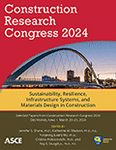A Literature Review of Carbon Emissions Monitoring Practices in Construction Projects
Publication: Construction Research Congress 2024
ABSTRACT
Climate change is a significant issue that may impact many aspects of our lives. The increase in global carbon emissions is one of the main reasons for such environmental consequences, and immediate action should be taken to manage the carbon footprint from human activities. Carbon releases from the construction sector contribute to a significant fraction of greenhouse gases being released into our atmosphere. Hence, various efforts have been made to manage the amount of carbon emissions in construction projects, such as developing standards, methods, and tools. While many earlier studies were associated with conventional analytical methods for estimating carbon discharges, recent studies have focused on monitoring the actual status of carbon emissions in a project, enabling project teams to take timely responses to minimize releases. This paper reviews carbon emissions monitoring practices that can be applied in construction projects and provides a descriptive analysis. The review explains the type of technology adopted and indicates the project life-cycle stage that each application was designed to be used. The findings from this paper will provide an overview of the state-of-the-art practices for carbon emissions monitoring and identify future directions for research.
Get full access to this article
View all available purchase options and get full access to this chapter.
REFERENCES
Abanda, F. H., Tah, J. H. M., and Cheung, F. K. T. (2013). Mathematical modelling of embodied energy, greenhouse gases, waste, time-cost parameters of building projects: A review. Building and Environment, 59, 23–37. https://doi.org/10.1016/j.buildenv.2012.07.014.
Abdi, A., Taghipour, S., and Khamooshi, H. (2018). A model to control environmental performance of project execution process based on greenhouse gas emissions using earned value management. International Journal of Project Management, 36(3), 397–413. https://doi.org/10.1016/j.ijproman.2017.12.003.
Ahn, C. R., Lewis, P., Golparvar-Fard, M., and Lee, S. (2013). Integrated Framework for Estimating, Benchmarking, and Monitoring Pollutant Emissions of Construction Operations. Journal of Construction Engineering and Management, 139(12), 1–11. https://doi.org/10.1061/(asce)co.1943-7862.0000755.
Akadiri, P. O., Olomolaiye, P. O., and Chinyio, E. A. (2013). Multi-criteria evaluation model for the selection of sustainable materials for building projects. Automation in Construction, 30, 113–125. https://doi.org/10.1016/j.autcon.2012.10.004.
Devi, L. P., and Palaniappan, S. (2016). A Framework for the Assessment of Energy Use of High-Rise Building Construction Processes. Construction Research Congress 2016: Old and New Construction Technologies Converge in Historic San Juan - Proceedings of the 2016 Construction Research Congress, CRC 2016, 2039–2049. https://doi.org/10.1061/9780784479827.203.
Hajibabai, L., Aziz, Z., and Peña-Mora, F. (2011). Visualizing greenhouse gas emissions from construction activities. Construction Innovation, 11(3), 356–370. https://doi.org/10.1108/14714171111149052.
Heydarian, A., and Golparvar-Fard, M. (2011). A visual monitoring framework for integrated productivity and carbon footprint control of construction operations. Computing in Civil Engineering, June, 504–511. https://doi.org/10.1061/41182(416)62.
Heydarian, A., Memarzadeh, M., and Golparvar-Fard, M. (2012). Automated Benchmarking and Monitoring of Earthmoving Operation’s Carbon Footprint Using Video Cameras and a Greenhouse Gas Estimation Model. Computing in Civil Engineering, 509–516.
Huang, L., Krigsvoll, G., Johansen, F., Liu, Y., and Zhang, X. (2018). Carbon emission of global construction sector. Renewable and Sustainable Energy Reviews, 81(June 2017), 1906–1916. https://doi.org/10.1016/j.rser.2017.06.001.
IPCC. (2022). Climate Change 2022: Impacts, Adaptation and Vulnerability. August, 37.
Kwok, K. Y. G., Kim, J., Chong, W. K. O., and Ariaratnam, S. T. (2016). Structuring a Comprehensive Carbon-Emission Framework for the Whole Lifecycle of Building, Operation, and Construction. Journal of Architectural Engineering, 22(3), 1–12. https://doi.org/10.1061/(asce)ae.1943-5568.0000215.
Lai, K. E., Abdul Rahiman, N., Othman, N., Ali, K. N., Lim, Y. W., Moayedi, F., and Mat Dzahir, M. A. (2023). Quantification process of carbon emissions in the construction industry. Energy and Buildings, 289, 113025. https://doi.org/10.1016/j.enbuild.2023.113025.
Liu, G. W., Chen, R. D., Xu, P. P., Fu, Y., Mao, C., and Hong, J. K. (2020a). Real-time carbon emission monitoring in prefabricated construction. Automation in Construction, 110. https://doi.org/10.1016/j.autcon.2019.102945.
Liu, G. W., Yang, H., Fu, Y., Mao, C., Xu, P. P., Hong, J. K., and Li, R. Y. (2020b). Cyber-physical system-based real-time monitoring and visualization of greenhouse gas emissions of prefabricated construction. Journal of Cleaner Production, 246. https://doi.org/10.1016/j.jclepro.2019.119059.
Mardiana, A., and Riffat, S. (2015). Building Energy Consumption and Carbon dioxide Emissions: Threat to Climate Change. Journal of Earth Science & Climatic Change, s3, 1–3. https://doi.org/10.4172/2157-7617.s3-001.
Mukherjee, A., and Cass, D. (2012). Project Emissions Estimator Implementation of a Project-Based Framework for Monitoring the Greenhouse Gas Emissions of Pavement. Transportation Research Record, 2282, 91–99. https://doi.org/10.3141/2282-10.
Onat, N. C., and Kucukvar, M. (2020). Carbon footprint of construction industry: A global review and supply chain analysis. Renewable and Sustainable Energy Reviews, 124(February), 109783. https://doi.org/10.1016/j.rser.2020.109783.
Silvestre, J. D., De Brito, J., and Pinheiro, M. D. (2014). Environmental impacts and benefits of the end-of-life of building materials - Calculation rules, results and contribution to a “cradle to cradle” life cycle. Journal of Cleaner Production, 66, 37–45. https://doi.org/10.1016/j.jclepro.2013.10.028.
Tao, X. Y., Mao, C., Xie, F. Y., Liu, G. W., and Xu, P. P. (2018). Greenhouse gas emission monitoring system for manufacturing prefabricated components. Automation in Construction, 93(June 2018), 361–374. https://doi.org/10.1016/j.autcon.2018.05.015.
United Nations Environment Programme. (2022). 2022 Global Status Report for Buildings and Construction: Towards a Zero–emission, Efficient and Resilient Buildings and Construction Sector.
Wong, J. K. W., Li, H., Chan, G., Wang, H., Huang, T., Luo, E., and Li, V. (2014). Virtual prototyping for construction site Co2 emissions and hazard detection. International Journal of Advanced Robotic Systems, 11(1). https://doi.org/10.5772/58439.
Wong, J. K. W., Li, H., Wang, H., Huang, T., Luo, E., and Li, V. (2013). Toward low-carbon construction processes: The visualisation of predicted emission via virtual prototyping technology. Automation in Construction, 33, 72–78. https://doi.org/10.1016/j.autcon.2012.09.014.
Yeo, Z., Ng, R., and Song, B. (2016). Technique for quantification of embodied carbon footprint of construction projects using probabilistic emission factor estimators. Journal of Cleaner Production, 119, 135–151. https://doi.org/10.1016/j.jclepro.2016.01.076.
Information & Authors
Information
Published In
History
Published online: Mar 18, 2024
Authors
Metrics & Citations
Metrics
Citations
Download citation
If you have the appropriate software installed, you can download article citation data to the citation manager of your choice. Simply select your manager software from the list below and click Download.
